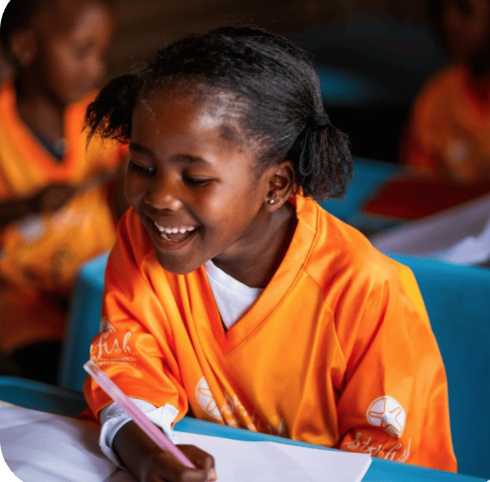May Blog Post - Education as a Path Out of Poverty
Introduction
Rocheleau from Brain Facts, an organization operated by the Society for Neuroscience, provides scientific information about the brain and nervous system. She declares that nearly half of the world’s two billion children live in poverty. She further states that one in five children lives in extreme poverty, which the United Nations defines as living below $1,90 a day. However, in South Africa, given our historical context, poverty is not just about financial distress; it is also about a lack of justice, human dignity, ethics, as well as physical and mental health.

A multiple overlapping deprivation analysis conducted by Statistics South Africa in 2020, found that six out of ten South African children are multidimensionally poor: 63.4% in the 5-12 age group and 62.5% in the 13 -17 age group. This means these children suffer from at least four out of seven deprivations. More than half of these children are found in rural areas. Deprivations include, but are not limited to: poor school facilities, sub-standard housing, long distance to the nearest health care centre, inadequate waste disposal, poor and variable access to early childhood education, low levels of education, unemployment and income poverty.

Poverty and Its Effect on Children
Poverty has been found to have devastating effects on children. Research has shown that malnutrition causes delays in children’s brain development and academic achievement. In addition, children from poor backgrounds have limited access to learning resources such as books, computers, and basic school supplies. This often causes them stress, lack of focus and a lack of an environment that is conducive to learning.
To make matters worse, most schools and homes in poor areas do not have adequate resources and infrastructure (such as water, electricity, technology, libraries and laboratories) to provide the same quality education and experience that is offered in more affluent areas. All these conditions hinder poor children’s ability to learn, to gain self-confidence and to thrive. As a result, their chances of obtaining good educational outcomes and getting good job opportunities which would improve their living standards and advance their lives, are limited.
The Cycle of Poverty
Poverty and a lack of education are intertwined - creating a cycle where poverty prevents access to quality education, and poor or a lack of education perpetuates poverty.
In South Africa, poverty manifests in different ways and affects different aspects of life. It causes conditions which in turn exacerbate or cause other conditions: Lack of financial resources leads to failure to provide school fees and other school essentials. This leads to children performing badly at school or dropping out of school. It also leads to poor housing, inadequate sanitation, overcrowding, lack of water and poor nutrition. All these conditions lead to diseases and poor health, which can lead to child-headed homes. Finally, lack of financial resources leads to child labour, which in turn prevents children from going to school. Lack of education leads to unemployment or poor-paying job,s which also perpetuate intergenerational poverty, where generation after generation remains in poor living and working conditions as well as in poor health.
The Starfish Intervention: Real Support for Real Futures
The Starfish Greathearts Foundation has been at the forefront of providing holistic, community-based support to vulnerable children across five provinces in South Africa. Recognising the layered impact of poverty on education, Starfish partners with local organisations to implement integrated programmes that support education, health, nutrition, and psychosocial development.
Starfish understands that you cannot educate a hungry, sick, or unsupported child. That’s why it supports Early Childhood Development (ECD) centres with educational materials, training for caregivers, and daily nutritious meals. Children also receive emotional and psychological support from trained Child Care Workers who visit families at home, ensuring that no child is left behind.
Case Study: Thando’s First Steps to Learning
At just three years old, Thando arrived at a Starfish-supported ECD centre in the Eastern Cape malnourished, withdrawn, and with limited speech. Living in poverty, she had never been exposed to stimulating play or learning.
Through daily structured activities, nutritious meals, and the care of trained practitioners, Thando began to thrive. She learned to speak confidently, interact with peers, and embrace early learning.
Today, she is ready to enter Grade R with the confidence and foundational skills every child deserves—all made possible through Starfish’s early childhood development support.
Breaking the cycle of intergenerational Poverty
The current South African President, Mr Ramaphosa has stated:
Education is about much more than personal betterment or obtaining a qualification to seek gainful employment. It is a ladder out of poverty … In a country such as ours, universal access to education is by far the most impactful intervention in breaking the cycle of intergenerational poverty. It is our most effective weapon to overcome the effects of centuries of racism, discrimination and marginalization of the black majority.
Indeed, research has found that education can and is the key to breaking the cycle of intergenerational poverty. Importantly, it is not simply access to education, but access to quality education, which yields these results – at both the country and individual levels. In such situations, educated parents benefit their children by providing home environments that foster education and success, thus improving the lives of, and future prospects for their children who will later earn higher incomes and improve their lives and circumstances. The country benefits in that educated children are able to join the workforce and become confident and productive workers; have the ability to be innovative and entrepreneurial, thus contributing to the country’s economic growth by driving the economy, creating new jobs and businesses that reduce poverty in the country.
Quality Education
In South Africa, quality education should not be limited only to reading and writing and to learning skills that will enable a child to earn more money. It should be about nation-building and creating a caring society that takes a long-term view of personal and national development. This would be done through offering a broad curriculum that focuses on the development of the whole individual, including their emotional, spiritual, cultural as well as physical and mental health.
For individuals and the country to benefit as outlined above, the education offered to all children has to be of a high quality. Such an education will empower children with knowledge and help them develop not only reading and writing skills, but also cognitive (especially analytical, creative and critical thinking), social, emotional, spiritual and communication skills. It will empower children with self-confidence and a caring and positive attitude. All these skills will later help individuals and businesses make informed decisions, solve problems and most importantly, reach their full potential while making a positive impact on other people, communities and the world.
As revealed by research into challenges facing township and rural African learners in South Africa, despite the country’s massive financial investment in education (about 20% of the country’s GDP), conditions, resources and educational outcomes in 75% of the country’s schools remain poor, while 25% well-resourced former white schools offer a better-quality holistic education.
The poor quality of education in the majority of schools is also borne out by the fact that the performance of learners in national and international assessments places them near the bottom of international performance lists. The most heart-breaking reality is that by Grade 4, the performance gap between children from poor and privileged schools is exceedingly wide and that children’s future success or failure is already predestined by that Grade.
These facts have significant implications for how education in Early Childhood Development and the Foundation Phases should be structured and improved countrywide. Interventions such as balanced regular nutritional support, a strong child and family psychosocial referral network, and funded transportation are only but a few examples of holistic design approaches in addition to the basic requirements of a suitable curriculum, appropriate infrastructure and appropriately trained and screened educators.
How Quality Education Affects Poverty
When children have acquired quality education, from a financial perspective, they are able to use their skills to earn higher incomes and thus improve their lives, while growing the country’s economy and competitiveness on the global stage. Furthermore, through their learnt ability to critically assess information and experiences, they can have the power to advocate for and to change legacy systems that keep people in perpetual poverty.
However, financial wellness becomes only one factor for consideration amongst many others, as they understand the interconnectedness of multiple variables for optimal and holistic living. For example, their improved financial means and their ability to acquire, understand, and use knowledge of proper nutrition and healthcare leads to better access to healthcare, and reduce their families’ vulnerability to diseases, poor physical development and early death. Concepts such as environmental impact and sustainability are understood and lead to better considered decision-making, not only at an individual level, but within communities and at societal level.
As they scale Maslow’s Hierarchy of Needs, intergenerational poverty and traumas are reduced through stronger family relationships and a common value system. They acquire dignity, and for them living is no longer in a setting of scarcity, and only about meeting the basic survival physiological needs. Instead, they have acquired resources for shelter and safety, a network of friends and a sense of community. Their self-confidence, respect and hope for the future, is regained as they reach fulfillment and live to their full potential.
Conclusion
In conclusion, education is essential in reducing poverty and in creating a prosperous and equal society in which all people are valued and are allowed to participate in the development of their country. By investing in quality education for all, countries can foster economic growth and break the cycle of intergenerational poverty.
References
Cele-Sangweni, E.E.S. 2021. Challenges Posed by the Use of English as the Language of Learning and Teaching in KwaZulu-Natal (KZN) High Schools. Unpublished PhD thesis. University of Zululand.
graduation alliance. Com. 2022/02/04. How education Breaks the Cycle of Poverty
Noble Non-Profit. No date. The Role of Education in Breaking the Cycle of Poverty. https://www.noblenonprofit.org
Ramaphosa, C. 2024. Education is the most Powerful Weapon Against Poverty. Government Opinion.www.gov.za/blog/education-our-most-powerful-weapon-against- Poverty
Rocheleau, J. 2019. How Poverty Shapes a Child’s Mind and Brain. Brainfacts.org/neuroscience-in-society/law-economics-and-ethics
Spada, A. et al. 2023. The Impact of Education and Culture on Poverty Reduction: Evidence from Panel Data of European Countries. Social Indicators Research. https://doiorg/10.1007/s11205-023-03155-0
UNESCO. No date. We can only break the Poverty Cycle through Education. https://www.unesco.org
UNICEF. 2020. ZAF-Multidimensional- Child-Poverty Analysis-Policy Brief. www.unicef.org
Maslow, AH. 1987. Motivation and Personality. 3rd edition. Delhi, India. Pearson Education.

.jpg?width=50&name=IMG-20240927-WA0015%20(002).jpg)
.png?height=200&name=Placeholder%20image%20(10).png)




